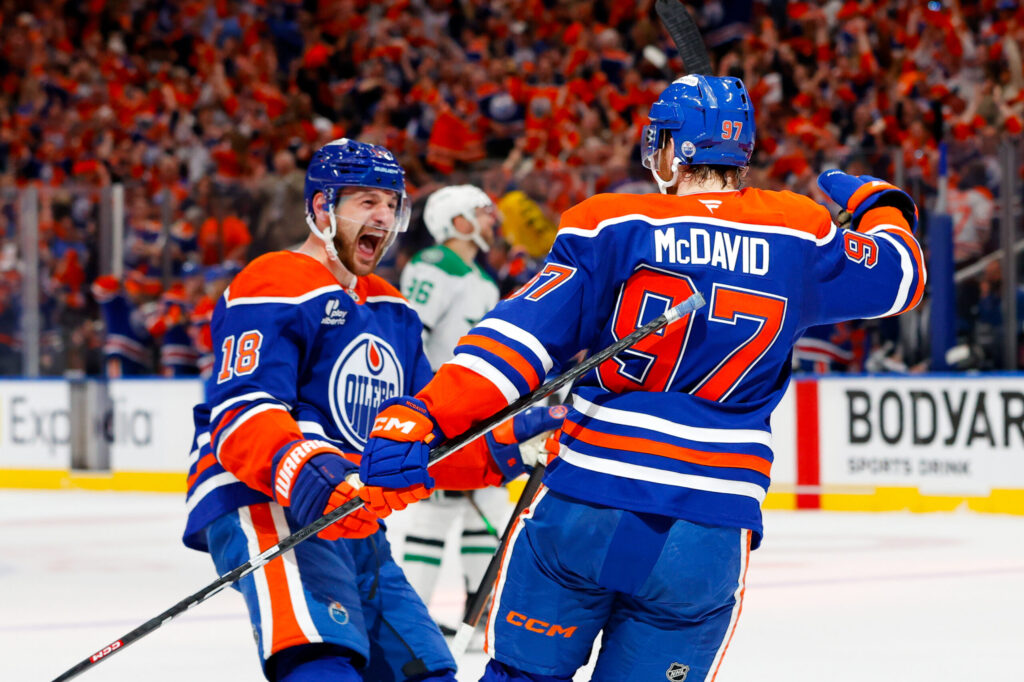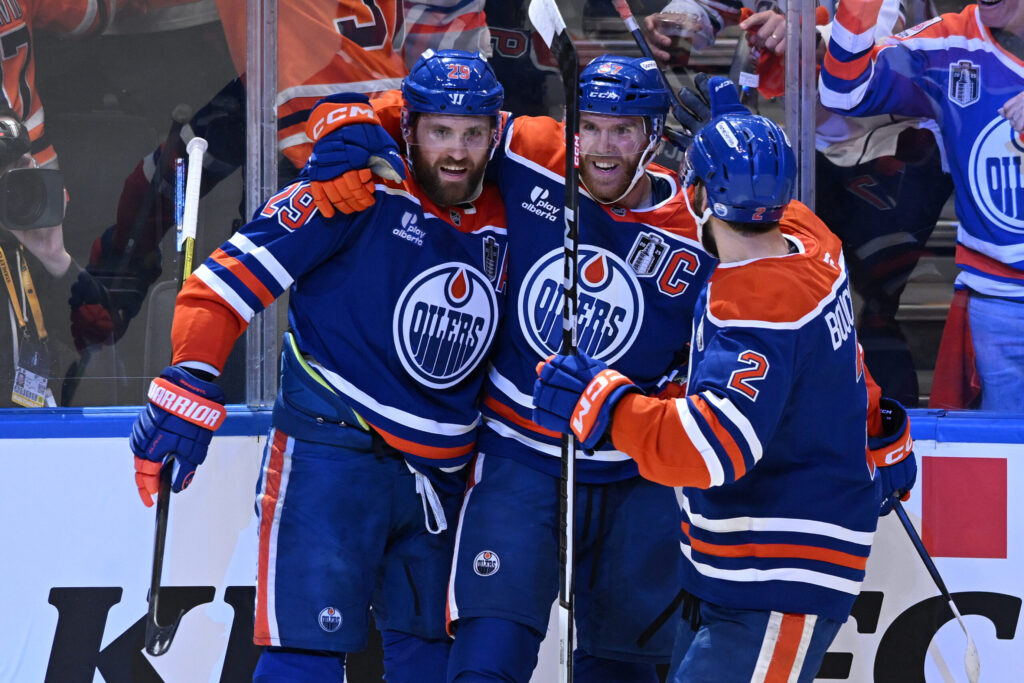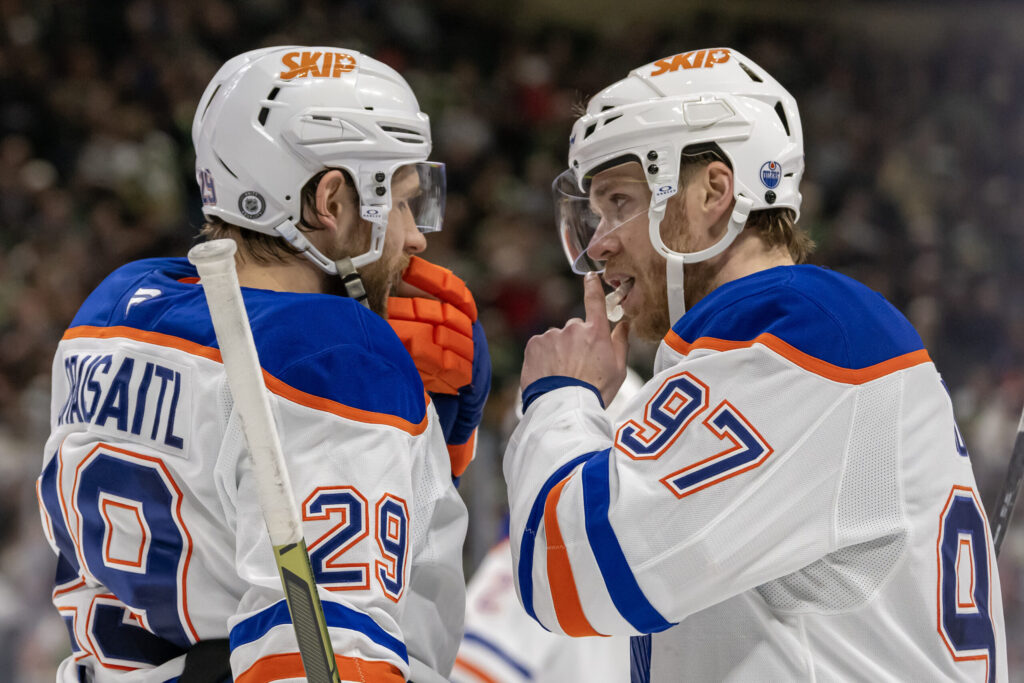The Edmonton Oilers are officially pushing the big red button. Forget easing into the season or saving the trump card for a desperate third-period push in February. Head coach Kris Knoblauch has confirmed the plan from day one of the 2025-26 campaign: Connor McDavid and Leon Draisaitl will start the year shackled together on the top line. The “nuclear option” is now the primary strategy.
For years, the debate has raged in Oil Country and across the league. Do you load up one unstoppable line, creating a matchup nightmare for opponents but potentially leaving the rest of your forward corps thin? Or do you split your two Hart Trophy winners, driving two distinct and dangerous lines to spread the offensive wealth?
Knoblauch has made his choice, and the Oilers will ice arguably the most potent duo in hockey history as a single unit when the puck drops against the Calgary Flames on Oct. 8. But this isn’t a panic move. It’s a calculated decision born from necessity, with a strategic philosophy that aims to rebalance the entire lineup.
The Hyman-Sized Hole
Let’s address the elephant in the room first. This strategic shift is significantly influenced by the absence of top-line winger Zach Hyman. The rugged, net-front presence is recovering from a wrist injury suffered during last season’s playoff run and isn’t expected back in the lineup until November at the earliest.
Hyman’s absence creates a significant void. His unique blend of tenacity, goal-scoring prowess, and ability to retrieve pucks for his superstar linemates is nearly impossible to replace internally. Without him, Knoblauch admitted the team is “a little slim on top-six winger talent.”

This is the crux of the problem. If you split McDavid and Draisaitl, you now need to find two competent top-six wingers to flank them from a depleted pool of candidates. Knoblauch was candid in his assessment, suggesting that separating his stars under the current circumstances could lead to two lines that the coaching staff “doesn’t really like.” By putting them together, he guarantees one truly elite, game-breaking unit. The alternative was risking two lines that were merely good, but not great—a compromise the Oilers are unwilling to make.
Also on the EDGE – All Eyes Are on the Edmonton Oilers’ High-Stakes Training Camp
A Counterintuitive Cascade
Here’s where Knoblauch’s strategy gets interesting and reveals a deeper, more nuanced approach. While stacking the top line seems like a move that would shorten the bench and marginalize the bottom-six, the coach argues it will have the opposite effect.
Think about the ice time distribution when McDavid and Draisaitl anchor their own lines. Each player routinely logs between 21 and 22 minutes per night. That’s a combined 42-44 minutes of ice time dominated by just two skaters, often leaving the third and fourth lines with sporadic shifts and little opportunity to find their rhythm. It’s tough to be an effective energy line when you’re sitting on the bench for eight-minute stretches.
By combining them, the total ice time for that one super-line might be high, but it opens the door for the other three lines to settle into a more regular and predictable rotation. The second, third, and fourth lines can roll over the boards with more frequency, keeping them engaged physically and mentally. This approach, Knoblauch believes, allows the other nine forwards to stay in the game and contribute more meaningfully. It’s a classic case of addition by, well, addition to a single line.
Putting Players in a Position to Succeed
Beyond the logistics of ice time, the move is about maximizing the potential of the entire forward group by clarifying roles. Not every forward is built to think the game at the warp speed of a Connor McDavid or handle the unique offensive creativity of a Leon Draisaitl. Forcing a player whose identity is built on a strong checking game or high-energy forechecking into a top-six scoring role is often a recipe for failure. It can neutralize their existing strengths without successfully cultivating new ones.

Knoblauch’s plan allows players to be what they are. A third-line checker can focus on being a third-line checker. An energy guy can focus on being an energy guy. They aren’t being asked to be something they’re not.
The coaching staff saw this principle bear fruit last season. When circumstances dictated, Ryan Nugent-Hopkins was tasked with centering his own line flanked by Vasily Podkolzin and Viktor Arvidsson. Freed from the shadow of the two megastars, “Nuge” drove a highly effective unit, and both Podkolzin and Arvidsson saw their individual offensive production spike. This is the model the Oilers hope to replicate. By creating one super-line, they empower Nugent-Hopkins to become the undisputed leader of a dangerous second line, creating a new set of matchup problems for opposing coaches.
Also on the EDGE – Stuart Skinner’s Transformation and the Quest for Redemption
The Golden Ticket
So, who gets the coveted spot on the wing alongside Nos. 97 and 29? The first crack goes to Trent Frederic. Acquired at the 2025 Trade Deadline, Frederic has spent his career as a bottom-six agitator with a scoring touch. He has never been given a legitimate opportunity in a top-six role, and this is the chance of a lifetime. The Oilers’ first preseason game against Seattle saw the trio of Draisaitl-McDavid-Frederic skate together, signaling this is more than just a training camp theory.
For their part, the stars seem eager to reunite. Draisaitl, who finished last season with 106 points in 71 games, called the chance to play with McDavid (100 points in 67 games) a “pleasure.”
The decision is made, and the logic is sound. Faced with a key injury, the Oilers are not just patching a hole; they are fundamentally restructuring their offensive attack. The plan is to overwhelm opponents with one transcendent line, while simultaneously creating a more balanced, four-line ecosystem where every player has a defined and achievable role. Whether it results in a top-heavy, predictable offence or a balanced and relentless attack remains to be seen. But one thing is certain: all eyes will be on Edmonton to see if the nuclear option can launch them into orbit.
Created with the aid of Gemini AI
